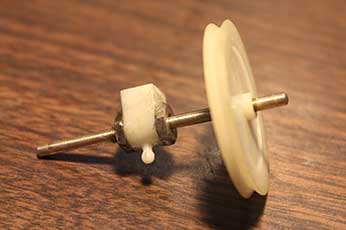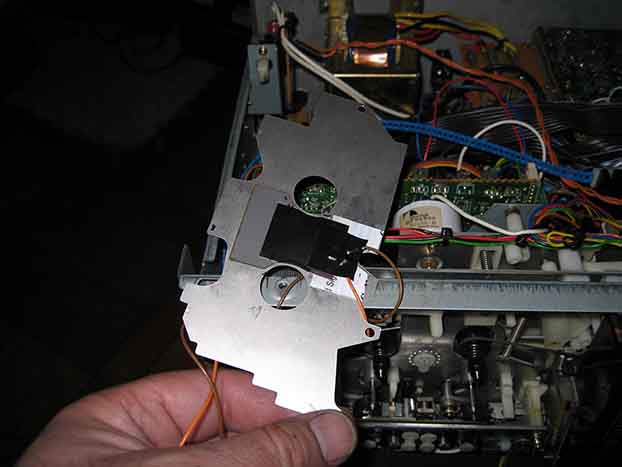Nakamichi Dragon - SUPERDRAGON
Nakamichi Dragon is Auto Reverse Cassette Recorder that means it can play the tape in both directions. You don't have to remove the cassette and flip it over to play side B. This feature is very demanding for proper tape alignment in Tape Transport Mechanism. Improper transport tape alignment can lead to more serious problems, specially with Auto Azimuth Feature trying to correct playback and actually damaging the tape causing the player "eating up" the tape.
All basic procedures listed below have to be done to restore the tape transport to proper operation:
- Check and clean Pinch Rollers and Heads. Check a condition and wear of Pinch Rollers. If excessive wear or micro cracks of rubber are visible, the Pinch Rollers have to be replaced. Use only pure alcohol with purity of not less than 98% to clean Pinch Rollers and Heads. Never use any gasoline related product to clean rubber, it dissolves rubber quickly.
- Clean and check the Idler Wheel Tire. Dirty or worn Idler Tire causing slow tape Rewind or Forward operation and often stalling tape movement during the playback. If good cleaning of Idler wheel tire and clutch not fixing the problem, the Idler wheel has to be replaced.
- Belts. Nakamichi Dragon has three important belts. One is for digital counter. The proper tension of that belt is important for correct “back tension ” in Reverse Playback mode. The second belt is Cam Motor Belt, very important for proper Head Base Stroke and basic operations of tape transport. The third belt is for Azimuth Motor mechanism. In all kind Cassette Decks all belts should be replaced after 20 years or less, depends of wear of particular Deck.
- Head Alignment. That is last thing what you can adjust. Most Decks have factory aligned heads and shouldn't be touch. But sometimes is necessary to correct it. Don’t do it, if you have no experience and proper test equipment to check correctness.
My Dragon had serious problems with tape transport from beginning. After replacement of Pinch Rollers, all belts and Idler Tire, I still couldn't get correct playback in reverse mode. Any Head Alignment couldn't help. The tape was skewing in reverse playback no matter what.

The problem was in Flywheels driver board and Flywheels adjustment. Took me a while to figure it out. The Scope was necessary to discover this problem. Two output transistors on Motor Control Board were leaking current, causing irregular spin of Flywheels, undetectable without proper test equipment.

After total perfect tune up of the tape transport mechanism, one more problem had to be corrected, the Head Azimuth Mechanism. That mechanism has plastic block sliding on threaded rod driven by Azimuth motor. The thread was damaged by often over driving this block out of the limits, caused by incorrect tape transport. The thread on this plastic slider block was totally worn and damaged.
I created improved version of this mechanism improving plastic thread slider block with 2 metal nuts, fixed with Epoxy to both sides of this block, running on the same rod with two springs on both ends, helpful with auto centering mechanism when was over driven.

Improved slider with metal nuts fixed to the slider block
o.jpg)
Improved Azimuth Mechanism with centering springs
The improved Azimuth Mechanism performs very well. After proper repair of Tape Transport that was a time for proper tune up of electronics. This is a basic rule. The Tape Transport must be adjusted perfect first, before we do any adjustment with heads and electronics.
This Dragon was tuned up back, up to specifications using Original Nakamichi Manual, which can be acquired from my Internet store. I didn't have original Nakamichi test tapes at the time, but I had handy TEAC Test tapes which are similar and very useful.
Don't use bulk recorded "universal" tapes commonly sold by various Electronic Parts Dealers. They have very poor quality recording, not up to the job of tuning up top quality equipment.
I use new TEAC Test Tape MTT-112SP for tune -10dB 315Hz reading level.
TEAC Test Tape MTT-114 for Azimuth 10kHz adjustment.
TEAC Test Tape MTT-150 Dolby level Calibration Tone 200nWb/m.
TEAC Test Tape MTT-111 for 3kHz Flutter test .
The first two are most important to have. The scope and good digital multimeter are required to perform perfect tunning. I did that kind of job "by ears" in the past on some tape recorders but it is not recommended if you want to do it correctly and have your decks reading and recording fully compatible with others.
After perfect calibration of playback and recording circuits, I decided to replace IC chips in first stage of playback circuit. Old TL072 are sounding good enough, but the new chips from National Semiconductor LM4562 are really worthed to try. They sound so natural with no noise and distortions any kind, that I decided to modify with that TEAC V-8030S, another "Flag Ship" Cassette Deck from my collection.


Illumination window for Cassette made from Electroluminescent Strip, the same was used for backlight of VU display.
Next recommended upgrade is more skills demanding. The very critical part in audio path is CMOS Analog Switch CD4066. Nakamichi Dragon has these IC's in audio path everywhere. They are often causing problems. The best option is to buy a lot of them, from different manufactures and select the best or get ANT4066 chips. However the ANT4066 chip requires some modifications in original control circuit.
On the end that was one more thing to do. I didn't mention it on beginning, but when I bought that deck on Ebay, one of the knobs for tape tune was missing. I tried to contact Nakamichi Service direct, to obtain some spare parts like this knob, but it is no way, to get anything that old.
I had to make a knob. So, I did it. Look on first page picture and tell me which knob is not original?
Next the biggest visible innovation on this old King of all Kings of Cassette Tape recording - The Auto Azimuth LED Display.
| TOP | NEXT>> |
|---|

